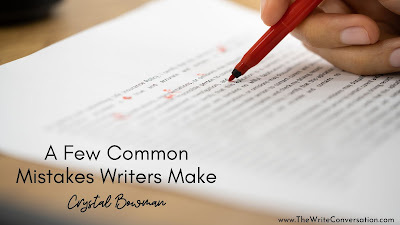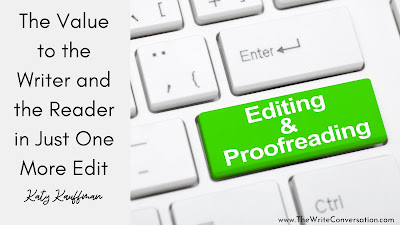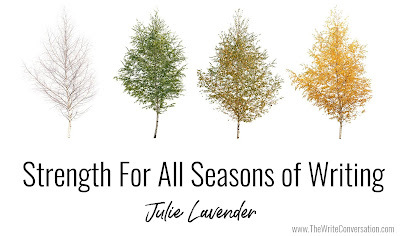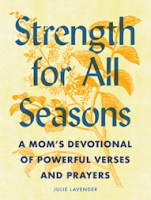Edie Melson's Blog, page 73
October 19, 2023
A Few Common Mistakes Writers Make

by Crystal Bowman
In both speaking and writing, grammatical errors are common. In light of eternity, it really doesn’t matter, but as professional writers we want to strive for excellence (not perfection). Here are some words and phrases that often get used incorrectly:
Then and thanThen indicates time and refers to the past or future. How old were you then?First, we will go to the movies. Then we’ll get ice cream. Than is a word for comparison:I’d rather play the piano than sing a solo. Their house is bigger than ours. Further and fartherFurther refers to a figurative distance, or something that is in addition or more. After further investigation, she was found innocent. Farther refers to actual distance. (What helps me remember is the word “far” within the word.)The museum was farther than they thought it was.All right and alrightAll right is two words. Alright has become acceptable because it is misused so often that CMS caved. As a professional writer—please write it as two words. Everything will be all right when you follow the rules.
Should of and should haveWhen someone writes or says, “I should of known better,” what they mean to say is, “I should have known better.” Now that you know better, use “should have.”
I could care less What the writer or speaker actually means is “I could not care less” or “I couldn’t care less.”I could not care less about the free offer.
Try and vs try toPeople often use the word “and” after the word “try” when the word should be “to.” When someone says, “I will try and fix the computer,” the correct way to phrase it is, “I will try to fix the computer.”
With two independent clauses, however, the word “and” correctly follows the word “try.”I will try, and then we’ll see what happens.
Whole other and whole notherThough I’ve never seen it written, people often use the word “nother” rather than “other” when they speak. Here is the correct verbiage:That’s a whole other subject that we will discuss tomorrow. Real and reallyReal is an adjective and really is an adverb.
Her ring is made from real silver.Close your eyes really tight.
So, those are my grammar tips for now. I hope you have a really good day and try to enjoy every minute. In the future, we can talk about punctuation, but that’s a whole other topic!
TWEETABLEA Few Common Mistakes Writers Make from author Crystal Bowman on @EdieMelson (Click to Tweet)
 Crystal Bowman is an award-winning, bestselling author of more than 100 books for children and four nonfiction books for women. She also writes lyrics for children’s piano music and is a monthly contributor to Clubhouse Jr. Magazine. She loves going to schools to teach kids about poetry. She also speaks at MOPS (Mothers of Preschoolers) groups and teaches workshops at writers’ conferences. When she is not writing or speaking, she enjoys going for walks, working out at the gym, and eating ice cream. She and her husband live in Michigan and have seven huggable grandkids.
Crystal Bowman is an award-winning, bestselling author of more than 100 books for children and four nonfiction books for women. She also writes lyrics for children’s piano music and is a monthly contributor to Clubhouse Jr. Magazine. She loves going to schools to teach kids about poetry. She also speaks at MOPS (Mothers of Preschoolers) groups and teaches workshops at writers’ conferences. When she is not writing or speaking, she enjoys going for walks, working out at the gym, and eating ice cream. She and her husband live in Michigan and have seven huggable grandkids. WWW.CRYSTALBOWMAN.COMWWW.FACEBOOK.COM/CRYSTAL.BOWMANWWW.FACEBOOK.COM/CRYSTALJBOWMANWWW.INSTAGRAM.COM/CRYSTALBOWMANAUTHOR
Published on October 19, 2023 22:00
October 18, 2023
Five Writing Tips for Moms of Young Kids
Edie here! Today I'm excited to introduce my friend, Christine Boatwright, today. She's an amazing writer with lots of talent and insight. Give here a warm Write Conversation welcome!

by Christine Boatwright @CBoatWrites
I rinsed the soapy sippy cup in hot water and set it on the drying rack.
Okay, if my main character finds out she’s pregnant, then she would need to tell her husband. But then her mom would say—
“Can I have a snack?”
The great plot point I’d uncovered vanished into thin air at the sound of my 6-year-old daughter’s voice. I wished I could tap a reminder into my phone, but my hands were wrist-deep in a mix of soap bubbles and old milk cups. Maybe I would remember it after the kids went to bed.
Does this sound familiar? As a mom of three young children, I don’t have hours of quiet alone time to hash out my current story. I sometimes daydream about such an opportunities, but they’re not currently in the cards.
The writing bug bit me not long after my first child was born. I wish it had tracked me down about five years earlier, but we don’t get to choose when God calls us to a new path. So, about eight years ago, I faced new motherhood and new writerhood at the same time.
Writing has been a blessing. It gave my mommy brain an outlet. I could set aside the Cheerio-filled snack cups, continue to avoid that pile of laundry, and dive into someone else’s brain in twenty-minute increments.
My first baby is now nearing nine years old, and I’m still on this writing journey. Some weeks I’m more productive than others—in both writing and motherhood—but I’m called to plug along with both.
Here are a few tips for when the domestic life buries your writing progress:
1. Carve out new writing times. I’m not the kind of gal who can write well in the midst of chaos. Sometimes my best writing comes from those early morning moments. If I choose to go to bed earlier than normal so I can wake up earlier, I find quiet times of solitude before little feet hit the floor. Or stay up later and write into the dark hours. Regardless, either way requires me to forfeit doom scrolling on Instagram until past my bedtime.
2. Mentally prepare to write. Can you imagine how much plotting we can get done in the school car line? If, instead of pulling out a book or my phone, I use those few (or many) minutes to plan out my next scene, I’ll be much more prepared when I next get the chance to write.
3. Ask your husband for dedicated writing time. This one can be a little tricky. When my husband finishes work for the day, he quickly dons his “dad” hat and doesn’t take it off until the kids are asleep. We’ve agreed to a schedule where he puts the kids to bed two nights a week, and I handle the rest. This lets me take my “mom” hat off for planned, uninterrupted writing time.
4. Invite your kids to join you. My oldest is a little budding writer. Sometimes we do writing sprints together and brainstorm his next scene, which is the cutest thing ever. Even my middle child, who can’t write well yet, can join us with a blank piece of paper and some creativity. They get to spend special time with Mama and share in something I love. However, if you have any ideas for entertaining my toddler, please let me know!
5. Ask for help. Mom guilt is a very real thing, and it can be heavy. Your writing time—and this call to write God has placed on your heart—is worthwhile. I formally give you permission to ask a friend or relative to come play with your little ones while you write. It’s a sweet way to let others minister to you. It’s not selfish.
I keep reminding myself that this is a season—a beautiful, messy season—but a short time, nonetheless. Older women often tell me to enjoy it, as it passes quickly. I believe them, but in some moments, the days can feel long. But seasons are short. Soon, my three beautiful children won’t need me quite so much, and then I’ll find maybe too many quiet hours to write. In the meantime, I’ll squeeze it in where I can. Let’s do what we can now to be even better writers in those next seasons.
TWEETABLEFive Writing Tips for Moms of Young Kids from @CBoatWrites on @EdieMelson (Click to Tweet)
 A church girl from the get-go, Christine Boatwright learned storytelling through her time as an award-winning journalist and academic writer. She's the president of the ACFW Upstate South Carolina chapter and has won a handful of ACFW awards for her debut manuscript. In her free time as a stay-at-home mom, she squeezes in words for her new manuscript, a split-time story mirroring the choices of Eve in the garden with a modern-day cancer researcher fighting the death released by the Fall. Connect with her at https://linktr.ee/christineboatwright
A church girl from the get-go, Christine Boatwright learned storytelling through her time as an award-winning journalist and academic writer. She's the president of the ACFW Upstate South Carolina chapter and has won a handful of ACFW awards for her debut manuscript. In her free time as a stay-at-home mom, she squeezes in words for her new manuscript, a split-time story mirroring the choices of Eve in the garden with a modern-day cancer researcher fighting the death released by the Fall. Connect with her at https://linktr.ee/christineboatwright

by Christine Boatwright @CBoatWrites
I rinsed the soapy sippy cup in hot water and set it on the drying rack.
Okay, if my main character finds out she’s pregnant, then she would need to tell her husband. But then her mom would say—
“Can I have a snack?”
The great plot point I’d uncovered vanished into thin air at the sound of my 6-year-old daughter’s voice. I wished I could tap a reminder into my phone, but my hands were wrist-deep in a mix of soap bubbles and old milk cups. Maybe I would remember it after the kids went to bed.
Does this sound familiar? As a mom of three young children, I don’t have hours of quiet alone time to hash out my current story. I sometimes daydream about such an opportunities, but they’re not currently in the cards.
The writing bug bit me not long after my first child was born. I wish it had tracked me down about five years earlier, but we don’t get to choose when God calls us to a new path. So, about eight years ago, I faced new motherhood and new writerhood at the same time.
Writing has been a blessing. It gave my mommy brain an outlet. I could set aside the Cheerio-filled snack cups, continue to avoid that pile of laundry, and dive into someone else’s brain in twenty-minute increments.
My first baby is now nearing nine years old, and I’m still on this writing journey. Some weeks I’m more productive than others—in both writing and motherhood—but I’m called to plug along with both.
Here are a few tips for when the domestic life buries your writing progress:
1. Carve out new writing times. I’m not the kind of gal who can write well in the midst of chaos. Sometimes my best writing comes from those early morning moments. If I choose to go to bed earlier than normal so I can wake up earlier, I find quiet times of solitude before little feet hit the floor. Or stay up later and write into the dark hours. Regardless, either way requires me to forfeit doom scrolling on Instagram until past my bedtime.
2. Mentally prepare to write. Can you imagine how much plotting we can get done in the school car line? If, instead of pulling out a book or my phone, I use those few (or many) minutes to plan out my next scene, I’ll be much more prepared when I next get the chance to write.
3. Ask your husband for dedicated writing time. This one can be a little tricky. When my husband finishes work for the day, he quickly dons his “dad” hat and doesn’t take it off until the kids are asleep. We’ve agreed to a schedule where he puts the kids to bed two nights a week, and I handle the rest. This lets me take my “mom” hat off for planned, uninterrupted writing time.
4. Invite your kids to join you. My oldest is a little budding writer. Sometimes we do writing sprints together and brainstorm his next scene, which is the cutest thing ever. Even my middle child, who can’t write well yet, can join us with a blank piece of paper and some creativity. They get to spend special time with Mama and share in something I love. However, if you have any ideas for entertaining my toddler, please let me know!
5. Ask for help. Mom guilt is a very real thing, and it can be heavy. Your writing time—and this call to write God has placed on your heart—is worthwhile. I formally give you permission to ask a friend or relative to come play with your little ones while you write. It’s a sweet way to let others minister to you. It’s not selfish.
I keep reminding myself that this is a season—a beautiful, messy season—but a short time, nonetheless. Older women often tell me to enjoy it, as it passes quickly. I believe them, but in some moments, the days can feel long. But seasons are short. Soon, my three beautiful children won’t need me quite so much, and then I’ll find maybe too many quiet hours to write. In the meantime, I’ll squeeze it in where I can. Let’s do what we can now to be even better writers in those next seasons.
TWEETABLEFive Writing Tips for Moms of Young Kids from @CBoatWrites on @EdieMelson (Click to Tweet)
 A church girl from the get-go, Christine Boatwright learned storytelling through her time as an award-winning journalist and academic writer. She's the president of the ACFW Upstate South Carolina chapter and has won a handful of ACFW awards for her debut manuscript. In her free time as a stay-at-home mom, she squeezes in words for her new manuscript, a split-time story mirroring the choices of Eve in the garden with a modern-day cancer researcher fighting the death released by the Fall. Connect with her at https://linktr.ee/christineboatwright
A church girl from the get-go, Christine Boatwright learned storytelling through her time as an award-winning journalist and academic writer. She's the president of the ACFW Upstate South Carolina chapter and has won a handful of ACFW awards for her debut manuscript. In her free time as a stay-at-home mom, she squeezes in words for her new manuscript, a split-time story mirroring the choices of Eve in the garden with a modern-day cancer researcher fighting the death released by the Fall. Connect with her at https://linktr.ee/christineboatwright
Published on October 18, 2023 22:00
The Value to the Writer and the Reader in Just One More Edit

by Katy Kauffman @KatyKauffman28
I didn’t want to upload it one more time. After nine scroll-through’s and uploads of my e-book to Kindle’s publishing platform, I didn’t want to fix my book again. Couldn’t it just be done? Couldn’t I get away with not fixing that spacing that I had somehow missed?
I knew the answer was no. And for good reason—to make my book the best it could be. Every hour I had spent formatting paragraphs and endnotes, every minute I had carefully scrolled through the whole book, every second of patience was worth the end result.
When you write, you know you’re going to have to edit. Oh, it would be nice for a paragraph to pop out right the first time! Sometimes they do. But more often than not, some wording will need to be tweaked, some sparkle will need to be added, and some principle will need to be refined. Editing is a guaranteed part of writing, and instead of a dread, it can be a relief.
A relief? How?
In our first draft, we can write from the heart based on the study we did of Scripture. In the second draft (and maybe the third and fourth and fifth), we can refine our main point and how we’ve developed it, and add more stories, explanations, and application.
Then we edit. We catch any typos and mistakes we’ve made. We streamline wordy sentences and make two paragraphs out of a chunky one. We shift gears—to see our writing from the reader’s viewpoint, not just the writer’s. We make our writing better and better, so it more fully expresses the message God has given us, and it can make just the right impact on readers’ hearts.
And … we catch those formatting mistakes that we missed the first eight times we scrolled through the file. Maybe you won’t have to scroll through your file nine times like I did, but even after the tenth time, it would have been worth it to scroll once more. The time we invest in polishing our writing is time invested in the hearts and minds of those who will read our work.
So don’t give up, dear writer-turned-editor. Every minute of editing is precious and a long-term investment in the ministry God has given you. If you have to, scroll through that file one more time.
What strategies do you use to put yourself in your reader’s shoes, so you can see your writing objectively? Join the conversation!
TWEETABLEThe Value to the Writer and the Reader in Just One More Edit from @KatyKauffman28 on @EdieMelson (Click to Tweet)
 Katy Kauffman is an award-winning author, an editor of Refresh Bible Study Magazine, and a co-founder of LIGHTHOUSE BIBLE STUDIES. She loves connecting with writers and working alongside them in compilations, such as Feed Your Soul with the Word of God, Collection 1 which is a 2020 Selah Awards finalist. She also enjoys encouraging writers and giving writing tips in her monthly writers’ newsletter called THE LIGHTHOUSE CONNECTION.
Katy Kauffman is an award-winning author, an editor of Refresh Bible Study Magazine, and a co-founder of LIGHTHOUSE BIBLE STUDIES. She loves connecting with writers and working alongside them in compilations, such as Feed Your Soul with the Word of God, Collection 1 which is a 2020 Selah Awards finalist. She also enjoys encouraging writers and giving writing tips in her monthly writers’ newsletter called THE LIGHTHOUSE CONNECTION.In addition to online magazines, Katy’s writing can be found at CBN.COM, thoughts-about-God.com, and three blogs on writing. She loves to spend time with family and friends, create art and make crafts with her group MY ARTSY TRIBE, and tend the garden in the morning sun. She makes her home in a cozy suburb of Atlanta, Georgia. Connect with her on FACEBOOK and TWITTER.
Published on October 18, 2023 11:08
October 17, 2023
13 Reasons Living With a Writer is a Spooky Thing to Do

by Edie Melson @EdieMelson
There are a lot of scary things about living with a writer. My husband and family know this only too well. Unfortunately, they’ve been subjected to just about everything on the list. And yet they still love me—even more than that they appear to enjoy my career choice at times.
Still, if you’re not expecting some of these things, they can be frightening. So since it’s October I thought I’d give those unsuspecting family members a sneak peak at the
13 Reasons Living with a Writer can Be Spooky
1. Going out in public can turn into a foray into the art and craft of eavesdropping. As writers—whether we writer fiction or nonfiction—we’re always looking for a good story. And I’ve found a lot of good stories by eavesdropping. For some reason this tendency makes my husband and family nervous.
2. Sometimes family members are drafted as impromptu actors when the resident writer is trying to accurately portray a scene. I'll just let your imagination run wild on this one. Trust me, it won't come close to the reality. 'nough said.
3. Normal dinner conversation can be off-putting for unsuspecting meal-time guests. For some reason people don’t like to discuss gory details during dinner—go figure.
4. Normal dinner conversation held at a restaurant can make those around you nervous. I remember the odd looks my husband and I got once while we were out. I was discussing different ways to kill people without leaving a trace. The looks from other diners were comical, to say the least.
5. Writer’s block is felt by the entire family. Ever hear the saying, if momma ain’t happy then nobody’s happy? Well if momma is a writer, then that’s doubly true of writer’s block.
6. Normal hours aren’t so normal. Writers write when inspiration hits. Hopefully that’s during daylight hours. But if the muse works the graveyard shift, so does the writer. Beyond that, if inspiration strikes at night, experienced writers know to write it down because it won't stick around until morning. It's the writing it down part that can cause family members difficulty. Imagine lights snapped on at 2am, loud exclamations as sleep-fogged writer tries to find a pen that works and something to write on. You get the idea. Inspiration isn't quiet.
7. Writers have an insatiable curiosity. I believe that trait is one of the reasons many of us are so successful. We go through life with a goal of finding out who, what, when, where, why and how. My husband refers to this as being nosy, but I think it’s a trait that’s stood me in good stead with my chosen career.
8. Writers don’t just write books, they also collect them. For some reason reading and writing go hand in hand. This means stacks of books everywhere. If you live with a writer, just get used to it. This is one battle you’ll never win.
9. Family situation frequently end up in print. Oh don’t worry too much, we’re careful to change the names. But the tendency of writers to write what we know, can almost always leave a trail back home.
10. Writers have a love/hate relationship with technology, especially computers. We all have our favorite brands and are fiercely loyal (can anyone say Apple?). But we also are the first ones to rail against the necessity of relying on such temperamental beasts.
11. Writers wear their hearts on their sleeves. A good review puts us over the moon. A bad review makes us vow to give up writing altogether. Just get ready for it, we’re an emotional bunch.
12. And along that line, writers are insecure. No matter how many good comments we get, it’s the one bad one that we’ll remember. We’ll dissect it, analyze it, and agonize over it for weeks.
13. We’re always afraid our last book (article, devotion, blog post, etc) was the last one we have in us. We’re certain we’ve reached the pinnacle of our career and the rest won’t be worth reading.
This is my list of the scariest things about living with a writer. I'd love to know what you'd add to the list. Be sure to leave your thoughts in the comments section below.
Don't forget to join the conversation!Blessings,Edie
TWEETABLE13 Reasons Living With a Writer is a Spooky Thing to Do from @EdieMelson (Click to Tweet)
 Edie Melson is a woman of faith with ink-stained fingers observing life through the lens of her camera. No matter whether she’s talking to writers, entrepreneurs, or readers, her first advice is always “Find your voice, live your story.” As an author, blogger, and speaker she’s encouraged and challenged audiences across the country and around the world. Her numerous books reflect her passion to help others develop the strength of their God-given gifts and apply them to their lives.Connect with her on her website, through Facebook, Twitter and on Instagram.
Edie Melson is a woman of faith with ink-stained fingers observing life through the lens of her camera. No matter whether she’s talking to writers, entrepreneurs, or readers, her first advice is always “Find your voice, live your story.” As an author, blogger, and speaker she’s encouraged and challenged audiences across the country and around the world. Her numerous books reflect her passion to help others develop the strength of their God-given gifts and apply them to their lives.Connect with her on her website, through Facebook, Twitter and on Instagram.
Published on October 17, 2023 15:22
October 15, 2023
Preparing to Promote Your Writing at Online Events

by Karen Whiting @KarenHWhiting
Since the early days of COVID many authors increased the amount of online speaking they do and also found it great for marketing their books. Prepare to use those opportunities for promotion.
Make Marketing EasyFor a live group event where you will be interviewed or leading a discussion, have any related books you wrote in reach. That makes it easy hold up while mentioning or reading from it. Make sure to hold it in front of the camera lens. If you have the e-book link you can get a universal link at Books2Read.com and use that.
It's also good to have a word document with a little introduction or little snippets about your books plus contact information that includes your web site's URL. You can copy and paste any information listeners might want into the chat instead of trying to type while talking. This can include talking points or tips you plan to share.
Engage the AudienceChoose a few good anecdotes to engage the audience. Make them relatable to your viewers as well as relevant to your books and brand. If you plan to mention great tips or steps to do something, have a handout prepared with a link for people to easily download. Make the most of handouts by creating an email sequence to gather emails.
Before the event, if it is public, share it in your social media. Encourage people to join in with a welcoming message and note about what you will cover. Add a photo of the book or a brief video.
Create Power PointsYou can generally share the screen and use a PPT. This helps viewers follow along and they can take screen shots of the slides. Or you can download the slides as photos and include a link to them at the end of the presentation. Be sure some of the slides include your website, book title, and other promotional information.
Check the ConnectionsIt's a good practice to be online ahead of time, especially with an interviewer. This way you can check your mic's volume, picture quality, screen share availability, and even you makeup before you click start.
Use Questions to Inspire InteractionFor live talks, be prepared for questions and ask for input. Craft questions that will stir imaginations or plug into memories people can share briefly. Ask people to describe in a nutshell a related memory or a tip that works for them on the topic you're discussing. Be sure to respond when people comment. Have a few comments or anecdotes you can add to keep the question lively.
Leverage GamificationPeople enjoy fun and games. Put a quick survey in the chat or see who can respond fast to a quiz type question. Or ask people to put in the chat a funny anecdote on your topic. You might even have a quick game with a prize.
Follow UpAsk people to put in their emails and save the chat. That way you can send an email to the people who attended and thank them for coming plus invite them to subscribe to your email list, and give them your landing page link where they can subscribe for a free download.
Develop an additional follow up handout after the talk based on what inspired the most interaction. This can then include comments people made that show you listened and cared about the audience. That's also an opportunity for showing appreciation and letting people know what they put in the chat or said that made you smile, think, or impacted you in some way.
RepurposeAfter the event consider what content engaged people and use that to create a new post, blog, or article. Or create a new tip sheet based on information that most excited the listeners. It might give you more ideas for future online talks to create.
It only takes minutes of preparation to promote while online!
TWEETABLEPreparing to Promote Your Writing at Online Events from @KarenHWhiting on @EdieMelson (Click to Tweet)
 Karen Whiting (WWW.KARENWHITING.COM) is an international speaker, former television host of Puppets on Parade, certified writing and marketing coach, and award-winning author of twenty-seven books for women, children, and families. Her newest book, The Gift of Bread: Recipes for the Heart and the Table reflects her passion for bread and growing up helping at her grandparent’s restaurant. Check out her newest book Growing a Mother’s Heart: Devotions of Faith, Hope, and Love from Mothers Past, Present, and Future. It's full of heartwarming and teary-eyed stories of moms.
Karen Whiting (WWW.KARENWHITING.COM) is an international speaker, former television host of Puppets on Parade, certified writing and marketing coach, and award-winning author of twenty-seven books for women, children, and families. Her newest book, The Gift of Bread: Recipes for the Heart and the Table reflects her passion for bread and growing up helping at her grandparent’s restaurant. Check out her newest book Growing a Mother’s Heart: Devotions of Faith, Hope, and Love from Mothers Past, Present, and Future. It's full of heartwarming and teary-eyed stories of moms.Karen has a heart to grow tomorrow’s wholesome families today. She has written more than eight hundred articles for more than sixty publications and loves to let creativity splash over the pages of what she writes. She writes for Crosswalk. Connect with Karen on Twitter @KarenHWhiting Pinterest KarenWhiting FB KarenHWhiting.
Published on October 15, 2023 22:00
October 14, 2023
Writers Will Find Value By Continuing to Write Even When Life is Stressful

by Tammy Karasek @TickledPinkTam
I’ve read quite a few articles of late which told the readers to never write while you are in the midst of a rough time. One even mentioned which times in particular. Included in the list was death of a loved one or friend, loss of health, loss of a job, severed relationship—whether family or friend, financial issues and more.
As a writer, I pondered the words shared in the articles at great length. Maybe I’d be the odd one in this thought, but I couldn’t help myself, and decided I would have to admit I disagreed with the statement, at least somewhat.
I would be prone to take the stance it’s best not to write a piece during the deepest of despair with plans to have it published soon after it was written. But I believe if you were to write when you are at the lowest of lows, in that gut-wrenching time when tears came faster than a smile could be planted on a face and the answer, “I’m fine” would be said, truth would be in those words. Those words of how wrecked you were at that moment.
I put this into practice. I promise I’m not giving you an idea I haven’t lived through. During a period of heartache, I went against those articles. I took an empty journal, and I went and sat somewhere different than my usual spot to write—outside a cute little tea and coffee shop. I had a clue I might not have dry eyes for long, and sat with my back toward the other table.
I had no intention for anyone to read the words, and they are sloppy for sure. But I thought of a scene in a novel of mine in progress. There is a scene where the emotions need to be written deep enough the reader will feel them. I took away the she was sad, and described the heartache I lived through. That scene is a messy mixture of fiction for my story and truth of the deep hurt I was in.
Will those few pages be in my book. Not all of them. But those where I was honest and I showed where it hurt, how it hurt, because I hurt—those I will use written for the book’s character.
I found this to be a great exercise and also a way to work through some of those losses we have. If you’re a fiction writer, but don’t have a sad scene at the moment, make the book be one filled with different emotions to pull from later. Angry with a situation or person, but not ready to settle the issue? Write out a scene you wish would be the resolution to that issue.
Are you a non-fiction writer? Do the same thing. If you are writing a book about loss of a relationship or death of someone, it more than likely will be several years before you are at a place where you could write how to live through, then move forward in your pain. But your notebook of feels will become a great resource to identify the depth of pain that someone may go through. You did, now here’s a couple ideas for them to try to begin their process to heal that worked for you. Maybe it can do the same for them.
Like I said above, I might agree somewhat with the statement not to write when you’re still hurting, I believe that needs further explanation. For me, I would say don’t write while you’re still hurting with the plan to publish those words anywhere for a while. But writing while you are in the midst of something deep and hard, then saved for the correct time, will be worth the massive amount of tears you will shed as you write it out.
What about you? Have you gone through a rough or sad time in your life then wrote what you felt as you worked through it? If so, have you thought about how useful those notebooks could be for you as you write sad, angry, or frightened scenes?
TWEETABLEWriters Will Find Value By Continuing to Write Even When Life is Stressful from @TickledPinkTam on @EdieMelson (Click to Tweet)
 Tammy Karasek uses humor and wit to bring joy and hope to every aspect in life. Her past, filled with bullying and criticism from family, drives her passion to encourage and inspire others and give them The Reason to smile. She’s gone from down and defeated to living a “Tickled Pink” life as she believes there’s always a giggle wanting to come out! A writer of Romance—with a splash of sass. She’s also The Launch Team Geek helping authors launch their books and also a Virtual Assistant for several best-selling authors. She is now under contract for her book on Launch Teams due to release Fall 2023. Her work was also published in a Divine Moments Compilation Book—Cool-inary Moments. She’s also the Social Media Manager for the Blue Ridge Mountains Christian Writers Conference, Founding President and current Vice-President of ACFW Upstate SC, and Founding President of Word Weavers Upstate SC. She’s a writing team member for The Write Conversation Blog, Novel Academy, MBT Monday Devotions, The Write Editing and more. Connect with Tammy at HTTPS://WWW.TAMMYKARASEK.COM.
Tammy Karasek uses humor and wit to bring joy and hope to every aspect in life. Her past, filled with bullying and criticism from family, drives her passion to encourage and inspire others and give them The Reason to smile. She’s gone from down and defeated to living a “Tickled Pink” life as she believes there’s always a giggle wanting to come out! A writer of Romance—with a splash of sass. She’s also The Launch Team Geek helping authors launch their books and also a Virtual Assistant for several best-selling authors. She is now under contract for her book on Launch Teams due to release Fall 2023. Her work was also published in a Divine Moments Compilation Book—Cool-inary Moments. She’s also the Social Media Manager for the Blue Ridge Mountains Christian Writers Conference, Founding President and current Vice-President of ACFW Upstate SC, and Founding President of Word Weavers Upstate SC. She’s a writing team member for The Write Conversation Blog, Novel Academy, MBT Monday Devotions, The Write Editing and more. Connect with Tammy at HTTPS://WWW.TAMMYKARASEK.COM.Featured Image: Photo by Christina @ wocintechchat.com on Unsplash
Published on October 14, 2023 22:00
October 13, 2023
Valuable Ways Writers Can Combat Anxiety

by Beth K. Vogt @BethVogt
Anxiety disrupted the rhythm of my days recently.
Not a pleasant occurrence, this undercurrent of uneasiness that appears when I least expect it and interrupts my plans for the day, including my writing goals.
But God promises to bring good out of all things, and that includes disrupted seasons like this one.
“Beth,” you wonder, “what good can come out of wrestling with anxiety?”
That’s just it. I’ve chosen not to wrestle with my worry, but to breathe through it—and in doing so, I’ve found myself drawing closer to God in the very moments when anxiety tries to win.
We creatives are gifted with sensitive, empathetic hearts that allow us to write books that connect with our readers on a personal level. But we need to guard our hearts too, so we don’t overload ourselves, which can lead to anxiousness.
This is where I’ve found the technique of prayer breathing to be so valuable. Prayer breathing combines the simple practice of box breathing, also known as square breathing, with meditating on specific scriptures.
Box breathing involves:Inhaling slowly through your nose for a count of fourHolding your breath for a count of fourExhaling slowly through your mouth for a count of fourHolding your breath for a count of four
As you breathe, you focus on a specific scripture to calm your heart and mind, such as:The Lord is my shepherd; I have all that I need. (Psalm 23:1) I give you all my burdens, and you will give me rest. (Matthew 11:28)Still my soul; You are God. (Psalm 46:10)
Focus on the first half of the scripture as you inhale and the second half of the scripture as you exhale. Repeat this process for five minutes, allowing the truth of the scripture to calm your heart.*
Prayer breathing isn’t an instant cure all for anxiety. You also may need to seek professional counsel depending on what else is going on in your life. But prayer—communication with God, one where you lean into his presence—is always a right choice.
*Information taken from Breath as Prayer: Calm Your Anxiety, Focus Your Mind, and Renew Your Soul by Jennifer Tucker, published by Thomas Nelson
TWEETABLEValuable Ways Writers Can Combat Anxiety from author @BethVogt on @EdieMelson (Click to Tweet)
 Beth K. Vogt believes God’s best often waits behind the doors marked “Never.” She’s authored 15 novels and novellas, both contemporary romance and women’s fiction. Beth is a Christy Award winner, an ACFW Carol Award winner, and a RITA® finalist. Her newest contemporary romance novel, Dedicated to the One I Love, released June 20, 2023. Her novel Things I Never Told You, book one in her Thatcher Sisters Series by Tyndale House Publishers, won the 2019 AWSA Golden Scroll Award for Contemporary Novel of the Year. An established magazine writer and former editor of the leadership magazine for MOPS International, Beth blogs for Learn How to Write a Novel and The Write Conversation and also enjoys speaking to writers group and mentoring other writers. She lives in Colorado with her husband Rob, who has adjusted to discussing the lives of imaginary people. Connect with Beth at bethvogt.com.
Beth K. Vogt believes God’s best often waits behind the doors marked “Never.” She’s authored 15 novels and novellas, both contemporary romance and women’s fiction. Beth is a Christy Award winner, an ACFW Carol Award winner, and a RITA® finalist. Her newest contemporary romance novel, Dedicated to the One I Love, released June 20, 2023. Her novel Things I Never Told You, book one in her Thatcher Sisters Series by Tyndale House Publishers, won the 2019 AWSA Golden Scroll Award for Contemporary Novel of the Year. An established magazine writer and former editor of the leadership magazine for MOPS International, Beth blogs for Learn How to Write a Novel and The Write Conversation and also enjoys speaking to writers group and mentoring other writers. She lives in Colorado with her husband Rob, who has adjusted to discussing the lives of imaginary people. Connect with Beth at bethvogt.com.
Published on October 13, 2023 22:00
October 12, 2023
Tips to Help Writers and Speakers Create an Effective PDF Handout

by Edie Melson @EdieMelson
Putting together a handout can be a tricky thing. It needs to stand alone and not leave those who refer back to it confused, but it also needs to be less than a word-for-word copy of what you’re teaching. In addition, the graphics need to complement the subject without out overpowering it. And finally, it needs to be something that won’t cost your students a fortune if they decide to print it out.
3 Components for a Successful HandoutValuable information (without being a script)Engaging graphicsPrintable
My favorite program to create PDF handouts is Canva.com. I have the pro version (paid) so I have access to all the necessary components. There is an excellent free version, but you’ll need to look elsewhere for graphics. I’ll share how to find those when we get to those steps.
I approach compose a handout using these components.
1. Branded. I try to create all my handouts in a similar style. I have my favorite fonts and graphic elements. And if I use color, I have a specific set of colors I always use. This means my handouts are recognizable no matter where my audience connects with me.
2. Title. This may seem obvious, but it’s critically important that your handout title is either the talk/class you’re presenting. Or, if it’s just a portion of the information presented be sure to use the EXACT wording you use when referencing it in your presentation.
3. Short intro. I like to give a short intro to make certain the person referencing the handout at a later time can immediately understand what is being shared. This isn’t the place for an illustration about why the info is important, just a straightforward sentence or two summing up what they’re about to read.
4. Formatting. I’m a stickler for scan-ability for notes. I want to make sure the person looking at the handout can immediately see the value and find the information they need. This means I look for ways to use lists, bullet points and bold headings.
5. Watermark. I want to provide handouts as additional information that can be used BY THOSE ATTENDING THE PRESENTATION at a later date. Sometimes I will spell out the fact that the material is copyrighted with this footer:
© Copyrighted Material. Do NOT reproduce without express written permissionEdie Melson • www.EdieMelson.com • Edie@EdieMelson.com
But most often I compose a footer that has my website and the page number (if the handout is more than 1 page long).
www.EdieMelson.com Page 1
6. Graphics. I try to find graphics that are simple and in black and white for ease in printing. Often I’ll use them in the title area. But sometimes I’ll use them at the bottom as well. Canva has an excellent variety, and they’re free if you have the pro version of Canva. If you don’t, you can visit www.Pixabay.com. This site has more than just images, they also have Vector graphics. You can do a search for the graphic you need, like calendar, and instead of image, choose to search for Vector graphic.
7. Bio. This one is optional. Sometimes I’ll include a short bio and headshot. It depends on the space I have and how familiar the audience is with me.
Graphic Design
Before we talk about creating the handout, let’s have a quick lesson on graphic design basics. There are certain things you want to keep in mind when you’re designing a handout so it’s aesthetically pleasing. Here are some conventions that will make your finished product look better.
1. Font Choices. This is a big one. Unless you are a graphic design expert who knows how to mix multiple fonts, keep your design simple. Two fonts is ideal and you want to avoid using more than 3 different fonts.
I usually choose two main fonts, one that’s a handwriting or script font, and one that’s a typeset font. Handwriting Fonts. You want to be careful and make certain EVERY letter is legible in the handwriting font you choose. Readability is a million times more important than using a font that’s pretty.Typeset Fonts. I prefer to use a typeset font that’s sans serif and has the ability for me to make it bold or italic. This gives me more options when I’m formatting the text and making the handout easy to read.
2. Font Size. I can’t give you a definite font size because different types of fonts vary widely in what’s readable. It’s important to experiment and make certain the font you’re using is readable in the size you’ve chosen.
Font Size can also be a valuable design tool. Using a larger size can emphasize words or phrases and sometimes this is a better choice than changing fonts completely.
3. Balance. Balance is different than symmetry. The best example I can think of is if you are decorating a fireplace mantle in your home. A symmetrical approach would be to have the exact same vase on either end, with a mirror hung exactly in the center. A balanced approach would be to have a vase with a flower arrangement that’s approximately 18 inches high on one end of the mantle, several paintings hung in the center and at the other end a stack of books with a small statue that all together is approx. 18 inches high.
This is a simplistic explanation, but the point is balance doesn’t always match, but it’s always pleasing to the eye. And that “eye” takes time and practice to develop.
What’s the point of this? The point is your page should have balance, but doesn’t have to match.
4. Graphics. The graphic images I use fall into several general categories. Graphics that illustrate: These would be images like an evergreen bough I used to illustrate a handout I did on Evergreen Writing.Graphics that divide: These are usually some kind of line or linear graphic that give a visual break between sections or points.Graphics that group: These would be something that helps set off a point, like corners or a square around text. This can also be a frame around the entire handout page.
A graphic element can be very subtle but still pack a big impact. Actually I think the judicious use of subtle graphics are what elevate handout from boring to extraordinary.
Other Things to Consider
Color. I recommend using color with a light hand. I try to keep the background of my handouts white. Otherwise if someone wants to print it out, it requires a color printer or at least extra ink if they’re printing it in grayscale.
If I’m doing something that I don’t expect or want printed out, I will sometimes use color to enhance the overall look. But even then, I use color lightly. Colors can appear very differently on different devices—from different brand or model computers to tablets to phones.
Also remember that your eyes read differently on a screen as opposed to a printed page. On a screen we need a high contrast—especially with poor lighting (poor lighting can mean low light or extreme bright light). That pale brown background with dark brown lettering is beautiful when printed, but a nightmare to read on a screen because the contrast isn’t sharp enough.
Using a Frame. Sometimes I like to use a frame around the entire handout. I tend to do this if the handout is short and has a lot of white space. I want my handouts to be perceived as valuable and that is often fed unconsciously by how “full” a page is.
Finally, save your handouts as a PDF, not a word document. This will ensure all the elements stay in place when your handout is printed.
These are my tips for creating a handout. I'd love to know what tips you have. Beside to leave your thoughts in the comments section below.
Don't forget to join the conversation!Blessings, Edie
TWEETABLETips to Help Writers and Speakers Create an Effective PDF Handout from @EdieMelson (Click to Tweet)
 Edie Melson is a woman of faith with ink-stained fingers observing life through the lens of her camera. No matter whether she’s talking to writers, entrepreneurs, or readers, her first advice is always “Find your voice, live your story.” As an author, blogger, and speaker she’s encouraged and challenged audiences across the country and around the world. Her numerous books reflect her passion to help others develop the strength of their God-given gifts and apply them to their lives.Connect with her on her website, through Facebook, Twitter and on Instagram.
Edie Melson is a woman of faith with ink-stained fingers observing life through the lens of her camera. No matter whether she’s talking to writers, entrepreneurs, or readers, her first advice is always “Find your voice, live your story.” As an author, blogger, and speaker she’s encouraged and challenged audiences across the country and around the world. Her numerous books reflect her passion to help others develop the strength of their God-given gifts and apply them to their lives.Connect with her on her website, through Facebook, Twitter and on Instagram.Featured Image: Photo by Ilya Pavlov on Unsplash
Published on October 12, 2023 22:00
October 11, 2023
Strength For All Seasons of Writing

by Julie Lavender @JLavenderWrites
Did you know the Bible uses the word “strength” more than 350 times?* One source puts this number just over 360, which I don’t see as a coincidence. Maybe we need at least one reminder of God’s strength for every day of the year?
They—whoever they are at the moment—point out that “be strong” shows up in various forms 13 times in the Bible, and the word “stronghold” appears 70 times in the Bible. One of my favorite phrases, “strong and courageous,”—makes an appearance three times in Deuteronomy, five times in Joshua, two times in 1 Chronicles, and one time in 2 Chronicles.

Each “strength” mention points us back to the Almighty Father in relation to a specific Bible story in the Old or New Testament. And I believe many of those verses—the promises and pointers—can apply to our lives as writers, from the newbie stage to the sunset days.
To celebrate the release of my newest book just two days ago— Strength for All Seasons: A Mom’s Devotional of Powerful Verses and Prayers , I’ll share some of my favorite strength verses.
Strength Verses for All Seasons of a Writer’s Journey
INFANT: the writing dream begins
But they who wait for the Lord shall renew their strength; they shall mount up with wings like eagles; they shall run and not be weary; they shall walk and not faint. Isaiah 40:31 ESVThe Lord is good, a stronghold in the day of trouble; he knows those who take refuge in him. Nahum 1:7 ESV
TODDLER: the writer stumbles and falls, but keeps toddling along
I can do all things through him who strengthens me. Philippians 4:13 ESV Fear not, for I am with you; be not dismayed, for I am your God; I will strengthen you, I will help you, I will uphold you with my righteous right hand. Isaiah 41:10 ESV
TWEEN: the writer learns, grows, and studies the craft
My flesh and my heart may fail, but God is the strength of my heart and my portion forever. Psalm 73:26 ESVThe Lord is my strength and my shield; in him my heart trusts, and I am helped; my heart exults, and with my song I give thanks to him. Psalm 28:7
TEEN: the writer gains independence with his/her first acceptance
Have I not commanded you? Be strong and courageous. Do not be frightened and do not be dismayed, for the Lord your God is with you wherever you go. Joshua 1:9 ESVWait for the Lord; be strong, and let your heart take courage; wait for the Lord! Psalm 27:14 ESV
ADULT: the writer settles into a comfortable routine of submitting and garnering acceptances
Be strong and courageous. Do not fear or be in dread of them, for it is the Lord your God who goes with you. He will not leave you or forsake you. Deuteronomy 31:6 ESV And you shall love the Lord your God with all your heart and with all your soul and with all your mind and with all your strength. Mark 12:30
GOLDEN YEARS: the writer enjoys the sweet success of a writing dream come true, praising God for the lives He’s blessed through the writer’s God-given words
Finally, be strong in the Lord and in the strength of his might. Ephesians 6:10 ESVSeek the Lord and his strength; seek his presence continually! 1 Chronicles 16:11 ESV
From the initial flicker of a writer’s dream to the vibrant sunset of accomplishments and dreams come true, writers need God’s strength to get through each season of the writing journey. Wherever you are along the path to publication, hang onto these strength-bearing passages to carry you each step of the way.
Join the conversation below and tell us your favorite “strength” verse below or share a time when you leaned into God’s strength to accomplish a writing goal.
TWEETABLEStrength For All Seasons of Writing from @JLavenderWrites on @EdieMelson (Click to Tweet)
 Julie Lavender’s newest book, Strength for All Seasons: A Mom’s Devotional of Powerful Verses and Prayers, released two days ago. Published by Zeitgeist, an imprint of Penguin Random House, Strength encourages moms to use God’s powerful words as reminders to seek God no matter the situation or circumstance. She’s thrilled that her previous PRH book, Children’s Bible Stories for Bedtime, is releasing as a bilingual version in December. And she’s super-excited that her two picture books will release in 2024 and 2025 from End Game Press and Wren & Bear Books.
Julie Lavender’s newest book, Strength for All Seasons: A Mom’s Devotional of Powerful Verses and Prayers, released two days ago. Published by Zeitgeist, an imprint of Penguin Random House, Strength encourages moms to use God’s powerful words as reminders to seek God no matter the situation or circumstance. She’s thrilled that her previous PRH book, Children’s Bible Stories for Bedtime, is releasing as a bilingual version in December. And she’s super-excited that her two picture books will release in 2024 and 2025 from End Game Press and Wren & Bear Books.
Published on October 11, 2023 22:00
October 10, 2023
Beware These Time Squanderers that Can Creep Into a Writer's Life

by Linda Gilden @LindaGilden
One Sunday my pastor preached a sermon from Luke 15 about the prodigal son who went to another country and squandered all the money his father had given him. When my pastor got to the word “squandered” it would not leave my mind.
First of all, that is just one of those words that stick with you. The sound of it brings a certain picture to mind. When you say it, you use facial muscles that you didn’t know you had. And although it is not a word that many people use frequently, once it surfaces in your vocabulary, you find yourself using it throughout the day.
Secondly, how could that word possibly apply to writers? We are busy people who need to make the most of our time to write. We have assignments, deadlines, interviews, critiques groups, etc.
As I thought about it I realized that there are several things that probably fall into the squandering category.
3 Time Squanderers for Writers
1. Time. This culprit can come in the form of a television, cell phone, Facebook, a friend who tempts us away from our projects, and much more. These things are all good and enjoyable. But when we are on a deadline, we must stay focused and protect our writing time until we are done. Perhaps a good way to approach these time usurpers is to use one of them as a reward.
In other words, let one of these things be your reward for completing a project. For me, I allow myself to read a good book that has been recently released. I see it on my bedside table and it reminds me to stay on task so I can hurry up and get to the book. You may be more interested in browsing the internet for good recipes, playing a game on your phone, or working in the garden. Whatever you like to do, use it as incentive to get your work done.
2. Energy. Even though we sit and write and to the outsider-looking-in it looks like we are not exerting much energy, writing is an exhausting activity. Writers pour so much mental and emotional energy into their writing that we often need to stop for a nap or walk to refresh our creativity. When you are on deadline, protect that energy. Exercising regularly will boost your energy level and stamina when you are on long writing binges. But beyond that, keep your hands to the keyboard.
3. Opportunity. This may seem to be a strange thing to include. But at most writers conferences writers leave with at least one or two invitations to submit something. I have heard that only 10-20% of those opportunities are followed through on. That may seem strange that we would let things that important fall through the cracks. But we do. Opportunities abound even in passing conversations, so don’t be one of the statistical folks who squander writing opportunities.
What does your writing day look like? Pay attention to the things you are squandering. Commit to making the most of your time. Use your resources wisely and you will be more productive.
TWEETABLEBeware These Time Squanderers that Can Creep Into a Writer's Life - @LindaGilden on @EdieMelson (Click to Tweet)
 Linda Gilden is an award-winning writer, speaker, editor, certified writing and speaking coach, and personality consultant. Her passion is helping others discover the joy of writing. Linda’s book, Articles, Articles, Articles! can give you more information about articles. She is the author of over two thousand magazine articles and 35 books including the new LINKED Quick Guides for Personalities series. As Director of the Carolina Christian Writers Conference, Linda helps many writers take the next step in reaching their writing goals. Linda’s favorite activity (other than eating folded potato chips) is floating in a pool with a good book surrounded by splashing grandchildren—a great source of writing material! www.lindagilden.com
Linda Gilden is an award-winning writer, speaker, editor, certified writing and speaking coach, and personality consultant. Her passion is helping others discover the joy of writing. Linda’s book, Articles, Articles, Articles! can give you more information about articles. She is the author of over two thousand magazine articles and 35 books including the new LINKED Quick Guides for Personalities series. As Director of the Carolina Christian Writers Conference, Linda helps many writers take the next step in reaching their writing goals. Linda’s favorite activity (other than eating folded potato chips) is floating in a pool with a good book surrounded by splashing grandchildren—a great source of writing material! www.lindagilden.comFeatured Image: Photo by Milad Fakurian on Unsplash
Published on October 10, 2023 22:00



